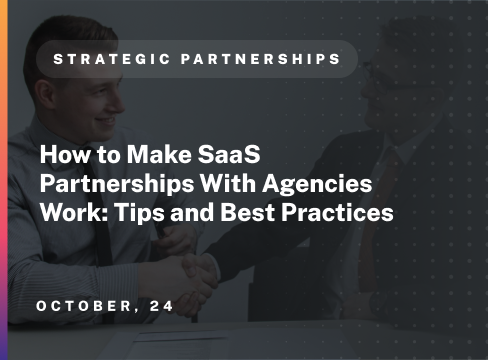When done right, forming a partnership between a SaaS company and a digital agency can be tremendously beneficial for both parties. However, SaaS partnerships can quickly go south without clear communication, strategic alignment, and a customer-centric approach.
Here are some best practices and insights from our expert Partnership Leaders panel of Graeme Byrd, Strategic Partnership Manager at Whip Around, George Haenisch, Head of Alliances at AnyRoad, Thorunn Devoy, Head of Partnerships at Talon One, and Todd Harris, Senior Vice President of Global Alliances at Valtech.
In this post, you’ll learn how to create win-win SaaS-agency partnerships focused on enabling great experiences.
Why SaaS Partnerships with Agencies Matter
Partnerships between SaaS companies and digital agencies can create tremendous value for both parties.
Byrd said “Agencies are looking for technology companies that offer a larger, broader platform that they can attribute multiple services to.”
Analytics, personalization, and automation may be areas where an agency seeks to leverage a SaaS partner to enhance its offerings.
Additionally, agencies look to partnerships as a source of new opportunities and expanded access. A partnership with the right SaaS company can open doors to new potential clients for an agency. SaaS companies, in turn, benefit from agencies’ design and development expertise.
Haenisch points out that tech companies provide the enabling technologies, but “You enable experiences. We actually design and build those things.”
The tech company creates the tools, while the agency turns them into end-to-end solutions.
Understanding these complementary roles is vital for mutually beneficial SaaS-agency partnerships. You can align expectations and collaborate smoothly when partners recognize what the other brings.
Best Practices for Tech Companies and Agencies
While each partnership is unique, some overarching strategies can enable collaboration. These partnerships require a long-term commitment from both sides, focused on enabling great customer experiences together versus short-term transactions.

1. Consultative Sales Approach
SaaS companies should embrace a consultative approach, investing significant time upfront to fully grasp each agency’s goals, challenges, and needs. This enables tailoring the partnership strategy and solution positioning for optimal adoption and outcomes.
“Partnerships require understanding your customer and their pain points,” said Devoy.
Rather than a generic sales pitch, dig deeper into relevant agency data, including:
- Customer profiles
- Intended use cases
- Desired business results
Let those insights drive the partnership configuration and presentation.
This level of custom consultation may require more work initially, but it pays dividends when the solution resonates strongly with the agency partner.
2. Focus on Long-Term Relationships
Partnerships easily derail when the SaaS company “loses sight of what and how a partner potentially operates,” said Harris.
To demonstrate lasting value and build trust over time, SaaS providers must look beyond the scope of the partnership itself. Seek a deeper understanding of the partner agency’s culture, approach, objectives, and motivations.
When SaaS companies invest in these long-view relationships, agencies are far more likely to reciprocate with equal commitment, engagement, and endorsement. Mutual prioritization leads to better alignment and advocacy.
3. Trainings and Certifications
Investing resources in thoroughly training and certifying agency staff significantly boosts platform adoption and drives success for joint customers. The more fluent and proficient the agency becomes in leveraging the SaaS capabilities, the more value it can deliver on an ongoing basis.
Per Haenisch, SaaS companies should “not charge for training” as an incentive to solidify partnerships.
Complementary to training, formal certification provides the agency a differentiator and competitive edge that cements loyalty to the partnership. Free training and certification show your willingness to invest in the relationship and make the agency more capable and valuable.
4. Avoid Labeling All Agencies As Prospects
Haenisch also advises SaaS companies to be selective and strategic when deciding which agencies to pursue partnerships with.
Rather than blanketing across all available options, carefully identify where there is likely the strongest mutual fit and clearly visible value-add – diluting partnership efforts too thin across too many prospects results in a lack of substance that helps no one.
By undertaking an informed analysis to pinpoint ideal potential partners, you can focus energy on forming fewer, deeper relationships poised for success – rather than spreading thinly across many superficial interactions unlikely to produce results.
Keys for Strong Communication
Strong communication and alignment are essential for successful SaaS-agency partnerships. Both parties must commit to transparency, active listening, and meeting the customer’s needs.
Open communication establishes trust and helps partnerships adapt to shifts. When communication breaks down, friction emerges.
Some best practices for maintaining strong communication include:
1. Active Listening and Understanding Goals
SaaS providers can better grasp the agency’s motivations, goals, and pain points by actively engaging in meaningful activities, such as:
- Discussions
- Thoughtful listening
- Asking probing questions
This critical legwork lays the foundation to refine the partnership approach for optimal alignment.
According to Harris, partnerships suffer when the SaaS company “stops listening” to its agency partner.
Harris stresses that misalignments often occur because the SaaS company fails to comprehend “what and how a partner potentially operates.” Devoting time to understanding their inner workings is vital.
2. Transparency and Collaboration
Lack of transparency from the SaaS provider quickly deteriorates trust with the agency, warns Haenisch. To solve this, you should maintain open lines of communication and keep the agency looped in on the following to enable true collaboration:
- Product developments
- Roadmaps
- Customer progress
Operating transparently – sharing information freely, being forthright about challenges, and inviting participation – conveys respect for the agency as an equal partner. When both parties commit to transparency, combined strengths can be leveraged for better customer outcomes.
3. Customer Experience Above All Else
In Haenisch’s view, partnerships go off course “when the partner stops listening and they lose sight of what’s best for the customer.”
Partners must check in frequently to ensure their interests are aligned on delivering maximum value to the end customer.
If strategies diverge or conversations devolve into pushing competing agendas, it helps to take a step back. Routine resets focused on the customer experience – not company priorities – can get partnerships re-centered on shared goals.
Conclusion: Are You Doing Your Partnership Right?
SaaS-agency partnerships can drive tremendous value but require the right strategies.
If your partnership seems misaligned, have candid conversations about resetting expectations and priorities. Prolonging detrimental situations helps no one. With mutual effort, almost any partnership can be turned around through trust-building, transparency, and strategic realignment.
As you move forward, continuously re-evaluate against best practices.
Are you demonstrating genuine commitment versus a transactional approach? Maintaining open flows of communication as partners? Keeping the customer at the center of every decision?
Be honest about gaps and course correct quickly. Doing so sets your partnership up for mutual success over the long haul.
Join The 1850+ Leaders Transforming Partnerships
As a member of Partnership Leaders you will:
- Build and learn with the top partner people at the best companies around the world.
- Increase your impact and accelerate your career with proven resources, tools, and best practices.
- Grow a network of peers, partners, and advisors with common objectives.


